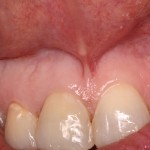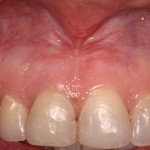Frenectomy Patient – Oklahoma City
The current patient was referred to me by her Orthodontist for a maxillary frenectomy. A frenectomy is a surgical procedure that completely removes the frenum, including its attachment to underlying bone. A frenum is a fold of mucos membrane, usually with inclosed muscle fibers. It attaches the lips and cheeks to the alveolar mucosa / gingiva and underlying periosteum. A frenum that encroaches on the margin of the gingiva may interfere with plaque removal, and tension on this frenum may tend to open the sulcus. This condition may be conducive to plaque accumulation and may inhibit proper toothbrushing.
- OKC patient with high frenula
- OKC patient healing complete
I completed the frenectomy in approximately 20 minutes, utilizing surgical scapels and periodontal knives. The patient was given scripts for all needed medications and post operative instructions. I evaluated the patients healing at a 10 day and 6 week post op. Surgical success included complete removal of the high frenula attachment with minimal to no post op pain or complications. The patient was very happy that a simple procedure could help keep her teeth straight after going through 2 years in braces.
Classification / Prevalence
Most frequently the labial frenum inserts in the mucogingival junction. The band of the attached gingiva may protect the free gum against the pull of the frenum during the lip movement. In certain cases, however, the upper and lower labial frenum is connected to the attached gingiva, occasionally even to the interdental papilla. Sometimes the frenum inserts in the attached gingiva and passes through the interdental papilla right up to the palate.
The attachment of the frenum to the upper jaw:
a. mucosal attachment in 46.5%
b. gingival attachment in 34.3%
c. papillary attachment in 3 .1 %
d. papilla penetrating attachment in 16.1%
The pull syndrome occurs in the following type of attachment:
a. mucosal in 4.5%
b. gingival in 53.4%
c. papillary in 100%
d. papilla penetrating in 84.0 %





 by
by 


